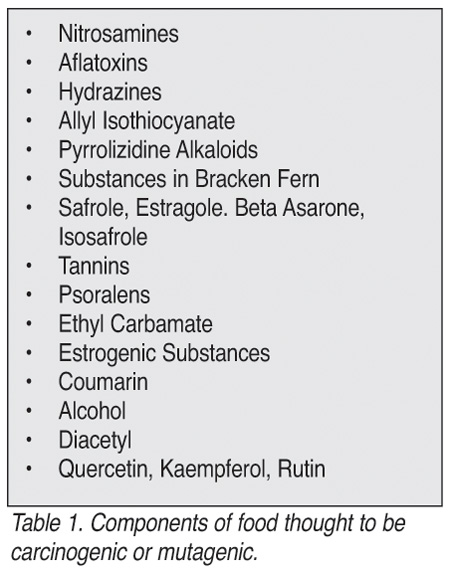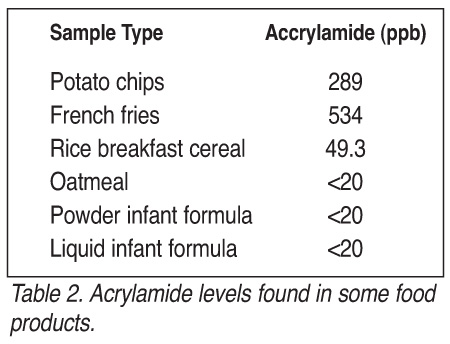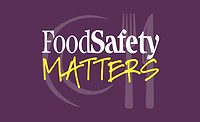Recent reports over the potential hazard posed by the presence of acrylamide in some starchy fried foods have many in the food industry searching for more information on the compounds themselves, as well as their presence in a diverse array of products. As a result, the food industry and researchers have undertaken a proactive approach to determine the extent to which these compounds may be present, as well as to accelerate research on their physiological effects. As the clamor over the acrylamide issue expands, it is important to remember that food products are well known as a source of many suspected carcinogens.
Overview of Food Carcinogens
 Researchers estimate that there are more than 200 known or suspected carcinogens in food, including 65 naturally occurring substances (Table 1). Although much of the research on cancer-causing agents in foods has focused on synthetic chemicals such as preservatives or colorants, cancer-causing chemicals that occur naturally in foods are far more numerous in the human diet. One of the most notorious of these is the family of nitrosamines.
Researchers estimate that there are more than 200 known or suspected carcinogens in food, including 65 naturally occurring substances (Table 1). Although much of the research on cancer-causing agents in foods has focused on synthetic chemicals such as preservatives or colorants, cancer-causing chemicals that occur naturally in foods are far more numerous in the human diet. One of the most notorious of these is the family of nitrosamines.
N-nitrosamines are one of the most toxic and predictably carcinogenic families of organic compounds encountered in the environment. Although no specific cases of human cancer have been directly related to exposure to nitrosamines, all animal species tested over the past 40 years have been susceptible to the carcinogenic effects of N-nitrosamines, and nearly all N-nitrosamines can cause cancer in at least one animal species. There are more than 300 known nitrosamines in foods and more than 90% of these are known to be carcinogens, mutagens or teratogens.
Although human exposure to nitrosamines can occur through a variety of routes, food has traditionally been looked at as the primary source. Nitrosamines may be formed within the body as a result of the ingestion of nitrates and nitrite. Although nitrate itself has not been found to be carcinogenic, it can be converted in the human body into nitrite. Nitrite can react with other chemicals in the body, such as amines and amides, to produce nitrosamines.
Several vegetables — beets, celery, lettuce, cabbage and spinach — contain notable amounts of nitrate. Although there have been concerns about the use of nitrite in the processing of cured meat products, only about 2% of the average daily intake can be attributed to this source. In 1978, the U.S. Department of Agriculture (USDA) eliminated the use of nitrate in most products. Nitrite use is limited and must be accompanied by a reducing agent, such as ascorbic acid or alpha-tocopherol, which prevents the formation of nitrosamines. The U.S. Food and Drug Administration (FDA) also has established action levels of 5 parts per billion (ppb) of n-nitrosodimethylamine in malt beverages and 10 ppb in malt barley.
Other prominent naturally occurring carcinogens include aflatoxins, which are produced by fungi that grow on peanuts, corn and other grains. Compounds in the hydrazine family that have been shown to be carcinogenic in animal tests are found in the three most commonly eaten mushrooms, as well as in pyrrolizidine alkaloids, which are found in many herbal teas. Tannins, which are found in coffee, tea and red wines and ethyl carbamate, which is found in naturally fermented foods and beverages, also have been found to have carcinogenic effects in animals.
In addition to the presence of naturally occurring carcinogens, research has shown that cooking and processing may produce carcinogenic agents. For example, research on cured meats has shown that nitrosamines are only found in bacon after it has been fried. In meat, most of the carcinogenic matter produced from the cooking process is a result of the breakdown of the meat protein resulting in chemicals such as heterocyclic amines. Tests such as these have raised the spectre that processing of other food products may produce potentially harmful compounds.
Accent on Acrylamide
The release of data from the Swedish National Food Administration that determined that carbohydrate rich foods processed at high temperatures may contain significant levels of acrylamide has resulted in a firestorm of debate. Subsequent studies have confirmed these findings and resulted in a World Health Organization (WHO) conference on the issue. Although studies have shown that rats that are fed high levels of the compound developed cancer at multiple sites, there are no comprehensive data on the relationship between human consumption and a carcinogenic risk.
 Acrylamide (CH2CHCONH2) is a colorless, odorless, flake-like crystal that is used to treat drinking water and for a variety of industrial purposes, such as in the manufacture of packaging materials. The Swedish study, which included more than 100 types of food, found significant levels of acrylamide — from 10 ppb to more than 2000 ppb — in products such as potato chips, French fries and bread (Table 2). By comparison, the U.S. Environmental Protection Agency (EPA) has set a maximum allowable level of acrylamide in drinking water in the U.S. at 0.5 pg/L (ppb).
Acrylamide (CH2CHCONH2) is a colorless, odorless, flake-like crystal that is used to treat drinking water and for a variety of industrial purposes, such as in the manufacture of packaging materials. The Swedish study, which included more than 100 types of food, found significant levels of acrylamide — from 10 ppb to more than 2000 ppb — in products such as potato chips, French fries and bread (Table 2). By comparison, the U.S. Environmental Protection Agency (EPA) has set a maximum allowable level of acrylamide in drinking water in the U.S. at 0.5 pg/L (ppb).
To facilitate continued study, a validated liquid chromatography-mass spectrophometric/mass spectrophotometric (LC-MS/MS) method for the determination of acrylamide in some products has been developed. The method has been validated for a variety of matrices (e.g., French fries, potato chips) and is in the process of validation for many more, including oatmeal, powdered infant formula and breakfast cereals. This instrumentation facilitates optimum chromatographic parameters and a mode of detection that provides improved precision, accuracy, selectivity and specificity. The LC-MS/MS method has a limit of quantitation of 20 ppb. Before analysis, fat is removed and an aqueous extraction is done to remove the acrylamide. The sample extract is then filtered, centrifuged and passed through a solid-phase extraction (SPE) cartridge. The acrylamide is quantified using a triple quadruple mass spectrometer.
Balancing Safety, Human Health and Hysteria
While publicity on foods and cancer has focused on the negative, it must be noted that food also contains many anti- carcinogens that offer protection against the harmful effects of a variety of natural and synthetic chemicals. In addition, despite the abundance of naturally occurring carcinogenic compounds, these compounds are generally consumed at levels so low that they pose little threat to human health. Although most regulatory and scientific organizations have yet to conclude that acrylamide present a risk to human health, any perceived risk by consumers is certainly a business concern. The adoption of validated methodology to accurately determine the presence and concentration of acrylamide can offer producers and consumers definitive information and peace of mind.
Randall Smith is UP., Analytical Services with Covance Laboratories, Inc., Madison, WI. In this role, Smith oversees the operations of the laboratories responsible for the analytical testing of food, pharmaceutical, nutraceutical and chemical products.
Rick Crowley is senior science writer, Covance Laboratories, Inc.
Analyzing Acrylamide: A Focus on Food Carcinogens




